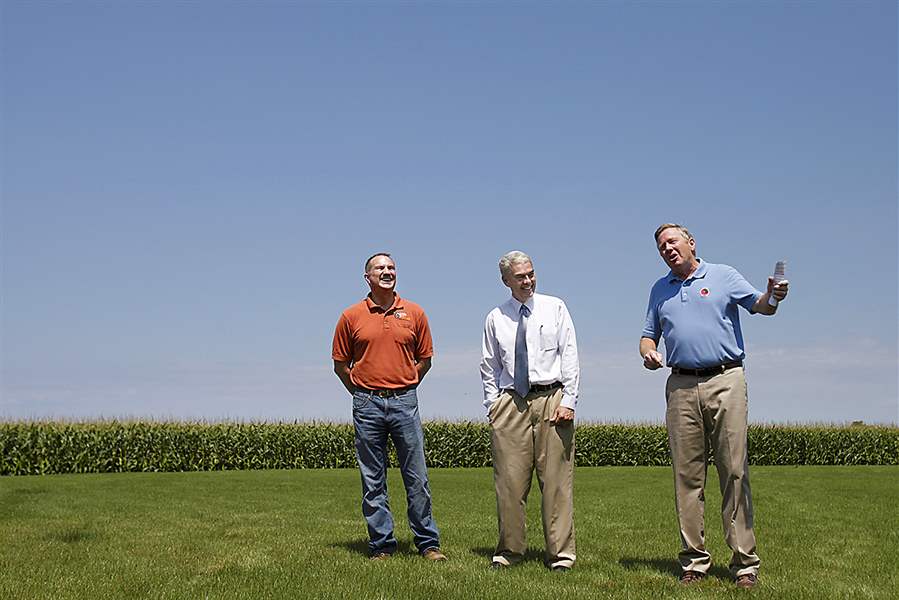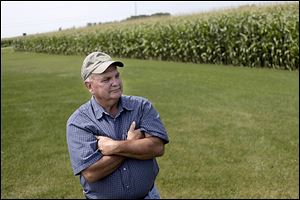
Event shows methods to curb fertilizer runoff into streams
Lake Erie Fund part of state effort
8/7/2013
James Zehringer, director of the Ohio Department of Natural Resources, right, speaks with State Rep. Tim Brown, left, and Sen. Randy Gardner about the Ohio Clean Lakes Initiative.
THE BLADE/JEFFREY SMITH
Buy This Image

James Zehringer, director of the Ohio Department of Natural Resources, right, speaks with State Rep. Tim Brown, left, and Sen. Randy Gardner about the Ohio Clean Lakes Initiative.
BOWLING GREEN — If fish could talk, they would likely approve of efforts some northwest Ohio farmers are undertaking to help keep oxygen-robbing algae from forming in Lake Erie and its tributaries.
Agriculture has historically been one of the greatest contributors to the algae problem because of fertilizers and animal manure that rain washes into rivers and streams. Those flow into Lake Erie’s shallow western basin, where they promote algae growth as they bake in warm summer water.
It’s been a constant battle to keep the principal nutrient, phosphorus, out of the water.
But at an event on the Mike Emch family farm off Dunbridge Road, between Perrysburg and Bowling Green in Wood County’s Middleton Township, reporters were given a look Wednesday at some of the more innovative farming techniques developed in recent years to reduce runoff from crop fields.
Those techniques include the use of cover crops, such as radishes and cereal rye grass, that help water penetrate soil along their roots and trap surface moisture with foliage.
Cover crops can reduce the need for fertilizers, which saves farmers money.
Other techniques include geographic system mapping in tandem with soil-sample data to help farmers better target their fertilizer applications, which also saves money.
They include structures to help control drainage, and machines to help fertilizers penetrate deeper into soil.
Jim Zehringer, director of the Ohio Department of Natural Resources who attended the site visit with state Sen. Randy Gardner (R., Bowling Green) and state Rep. Tim Brown (R., Bowling Green), said none offers sure-fire guarantees.
But Mr. Zehringer said those techniques are among many tools ODNR promotes to help protect Lake Erie, to balance the need for agriculture with the need for environmental protection.
“This is not just about agriculture,” Mr. Gardner added.

Mike Emch listens to techniques explained by the Ohio Department of Natural Resources in a tour of his family farm in Wood County's Middleton Township .
Sewer overflows and dredging also contribute to the problem, he said.
Mr. Brown said it’s important to curb algae because of its multibillion dollar impact on tourism and recreation, another one of Ohio’s biggest industries.
Northwest Ohio farmers are among many in the Great Lakes region expected to face more land-use pressure as the world’s population swells, the Earth’s climate warms, and water shortages in other parts of North America become more acute.
Farmers need to embrace algae-prevention techniques voluntarily to keep the federal government from imposing mandates on their industry they won’t like, Mr. Gardner said.
Mr. Gardner last year helped Wood, Hancock, Defiance, Henry, and Putnam counties receive $3 million in state funds for a pilot program, from which $2.3 million has been used.
Legislators have since put more money into that account, called the Healthy Lake Erie Fund. It now has a $1.1 million balance and is part of a broader state effort called the Clean Lakes Initiative, said Mark Bruce, an ODNR spokesman.
Mr. Zehringer used the event to stump for legislation proposed in the Ohio Senate that would allow crop farmers, not just livestock operators, to get credit for nutrient-reduction efforts. Farmers who demonstrate success at controlling runoff could use that data to avoid more onerous mandates, he said.
Contact Tom Henry at: thenry@theblade.com or 419-724-6079.